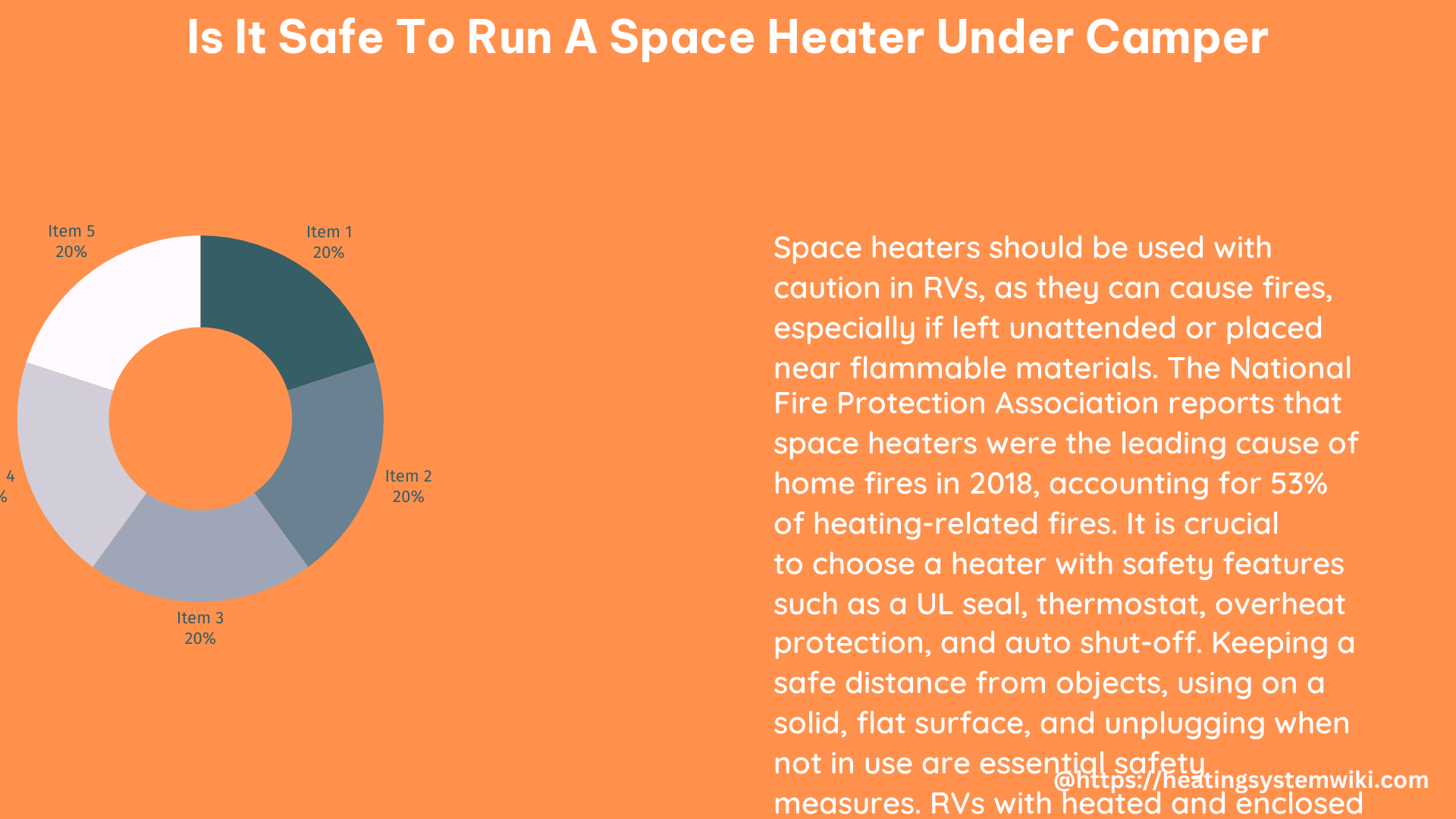Running a space heater under a camper can be a practical solution for keeping the interior warm during cold weather, but it’s crucial to ensure it’s done safely. This comprehensive guide will delve into the technical details and best practices to help you understand the risks and mitigate them effectively.
Outdoor-Rated Space Heaters: The Crucial Consideration
When using a space heater under a camper, it’s essential to choose a model that is specifically designed for outdoor use. Regular indoor space heaters may not be able to withstand the elements, such as moisture, wind, and temperature fluctuations, which can lead to malfunctions and increase the risk of fire.
Look for space heaters with the following features:
– Weatherproof housing: The heater should have a durable, water-resistant casing that can protect the internal components from the elements.
– Tip-over protection: The heater should automatically shut off if it’s knocked over, preventing potential fires.
– Overheat protection: The heater should have a built-in thermostat or sensor to prevent overheating and shut off the unit if it gets too hot.
– Corrosion-resistant materials: Components like the heating element and housing should be made of materials that can withstand exposure to moisture and outdoor conditions.
Ventilation: Safeguarding Against Carbon Monoxide

One of the primary concerns when running a space heater under a camper is the potential buildup of carbon monoxide, a colorless and odorless gas that can be deadly. Proper ventilation is crucial to ensure the safe operation of the heater.
Consider the following ventilation guidelines:
– Ensure the camper has adequate airflow, with vents or windows open to allow fresh air circulation.
– Position the space heater in a well-ventilated area, away from any enclosed or confined spaces.
– Monitor the space heater’s operation and be alert for any signs of improper ventilation, such as a stuffy or stale air environment.
– Install a carbon monoxide detector in the camper to alert you to any dangerous levels of the gas.
Placement and Positioning: Optimizing Heat Distribution and Safety
The location of the space heater under the camper can significantly impact its effectiveness and safety. Avoid placing the heater directly on the ground or in a position where it could come into contact with flammable materials, such as bedding or curtains.
Here are some tips for optimal placement and positioning:
– Position the space heater in a location where it can effectively heat the interior of the camper, focusing on areas where water lines run to prevent freezing.
– Elevate the space heater off the ground, using a sturdy, non-flammable platform or stand to keep it away from potential ignition sources.
– Ensure the heater is placed in a stable, level position to prevent it from tipping over or moving during operation.
– Maintain a safe distance between the space heater and any combustible materials, following the manufacturer’s recommended clearance guidelines.
Electrical Considerations: Matching Power Needs and Avoiding Overloads
The electrical system of your camper is a critical factor when using a space heater. Ensure that the heater’s power requirements are compatible with the camper’s electrical capacity to avoid overloading the system and potentially causing a fire.
Keep these electrical considerations in mind:
– Check the space heater’s wattage and amperage ratings to ensure they are within the safe operating limits of your camper’s electrical system.
– Use a dedicated, properly grounded electrical outlet for the space heater, and avoid using extension cords or power strips, which can create a fire hazard.
– Consider using a space heater with a built-in thermostat or automatic shut-off feature to prevent overheating and reduce the risk of fire.
– Regularly inspect the space heater’s power cord and electrical connections for any signs of wear or damage, and replace the unit if necessary.
DIY Heating Solutions: Retrofitting RV Air Conditioners
For those with a bit of DIY experience, it’s possible to install a heat strip in an existing RV air conditioner to provide an additional heating source for the camper. This approach can be a cost-effective and efficient way to supplement the camper’s heating system.
However, it’s crucial to note that this should only be done by a qualified professional to ensure it’s installed correctly and safely. Improper installation can lead to electrical issues, fire hazards, or other problems.
If you decide to pursue this DIY route, be sure to:
– Consult with a licensed RV technician or the air conditioner manufacturer to understand the specific requirements and safety precautions.
– Carefully follow all installation instructions and use only the recommended components and materials.
– Test the modified air conditioner thoroughly before using it to heat the camper, and monitor its performance closely during operation.
Conclusion
Running a space heater under a camper can be a safe and effective way to stay warm, but it requires careful consideration and adherence to safety best practices. By choosing the right outdoor-rated space heater, ensuring proper ventilation, positioning the heater correctly, and addressing electrical requirements, you can minimize the risks and enjoy a cozy camping experience.
Remember, if you have any doubts or concerns, it’s always best to consult with a qualified RV professional or the space heater manufacturer before using a space heater under your camper.
References:
– Keystone Forums – Is it Safe to Use a Space Heater Under My Camper?
– IRV2 Forums – Leaving Space Heaters On When You’re Out
– Stressless Camping – RV Space Heater Safety
– Reddit – Is it Safe to Use This Heater Under My Skirted RV?
– Jayco Owners Forum – Ceramic Heaters Underneath
